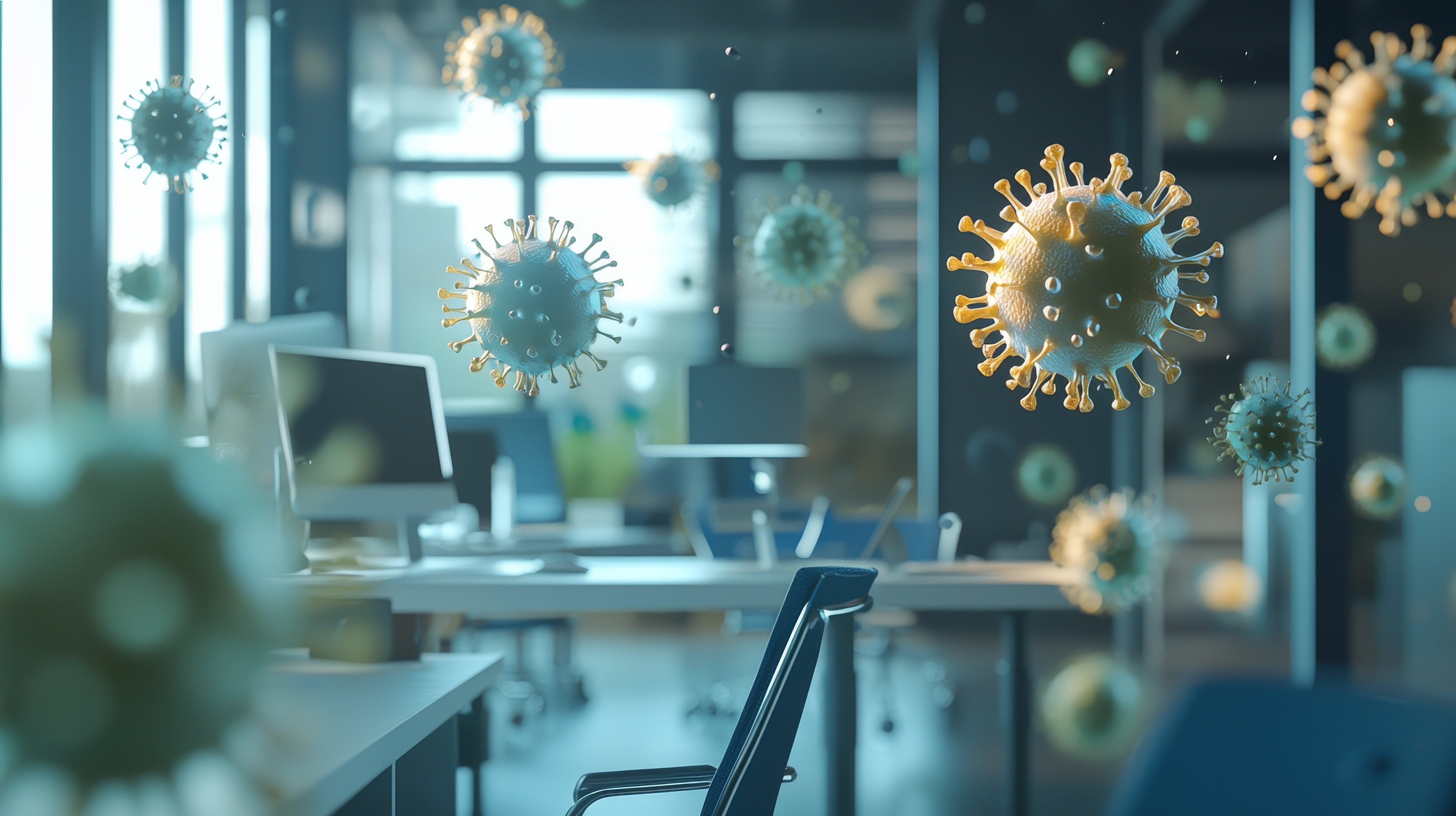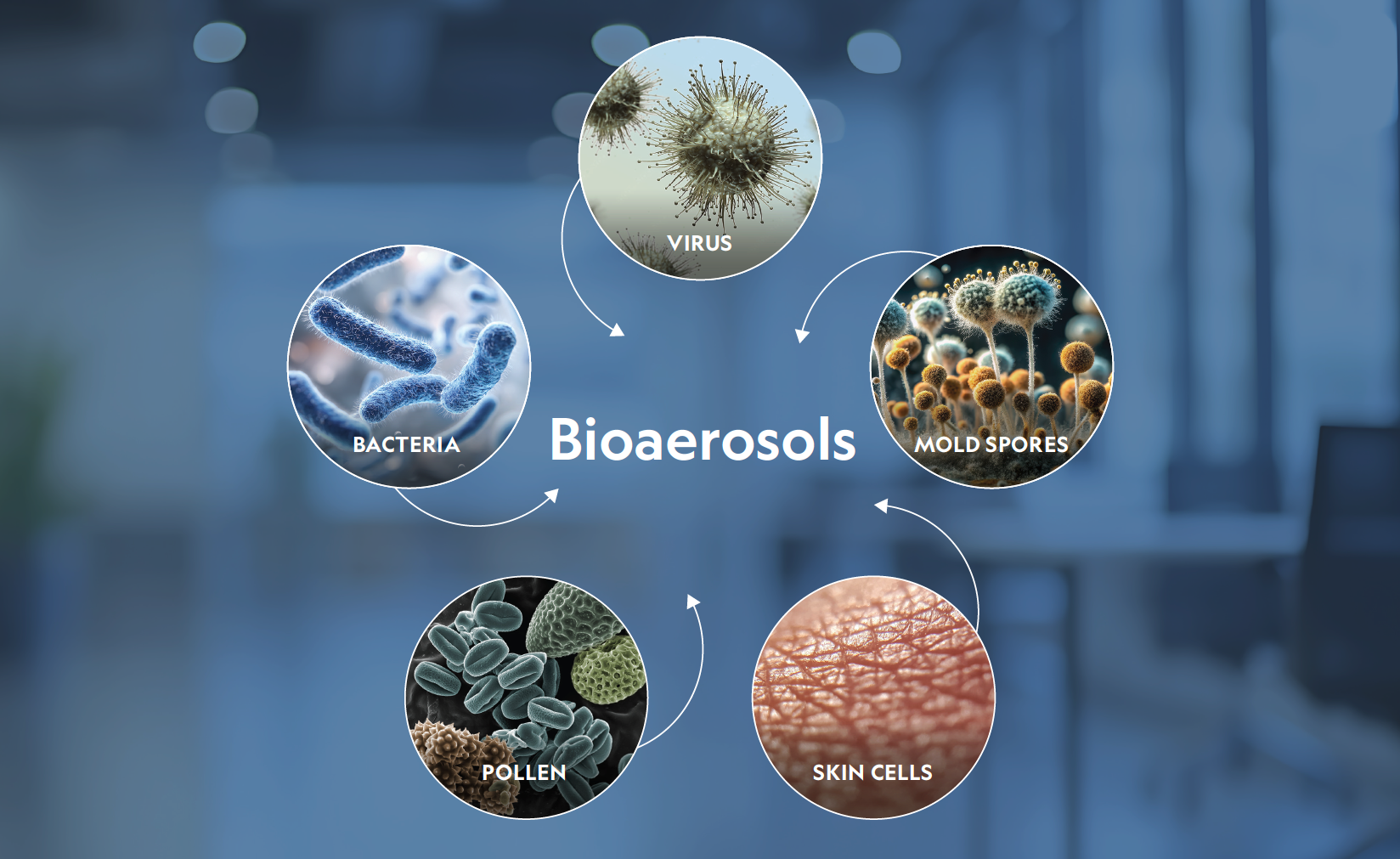The Air We Breathe
Published
Bioaerosols Explained
What They Are, Where They Come From, and Why They Matter for IAQ
Introduction
The Hidden Impact of Bioaerosols on Indoor Air Quality
In homes and commercial buildings across the US, especially in humid areas or older facilities, a hidden air quality issue is growing: bioaerosols.
When people hear the term “air pollution,” their minds often jump to smog, car exhaust, or visible dust particles hanging in the air. But a large portion of the pollution we breathe daily is invisible — and it doesn’t come from smoke or chemical emissions.
Instead, the pollution originates from living things.
These tiny airborne particles are known as bioaerosols, and they include everything from pollen and mold spores to bacteria, viruses, and microscopic fragments of skin cells. Some are harmless, but others can trigger allergies, worsen asthma, or even spread infectious diseases.
Understanding what bioaerosols are, where they come from, and how they impact our health is critical for improving indoor air quality (IAQ) in homes, schools, offices, and healthcare settings.
This guide will cover:
• What bioaerosols are and how they differ from microorganisms and pathogens
• Common examples and sources of bioaerosols
• Why they matter for human health, backed by the latest research
• How air purification can help reduce airborne pathogens and protect building occupants
What Are Bioaerosols?
Definition of Bioaerosols and Their Role in Indoor Air Quality
Bioaerosols are airborne particles that originate from living organisms or their byproducts.
They may be composed of microorganisms like bacteria, viruses, fungi, and protozoa; biological byproducts such as endotoxins, mycotoxins, and pollen proteins; or fragments of living matter including skin flakes, pet dander, or plant debris.
These particles range in size from less than 1 μm to more than 100 μm. Their microscopic scale allows many of them to remain suspended in the air for hours, traveling significant distances on indoor or outdoor air currents.
Because of this, bioaerosols can easily be inhaled and often accumulate in indoor spaces without proper ventilation or air purification.
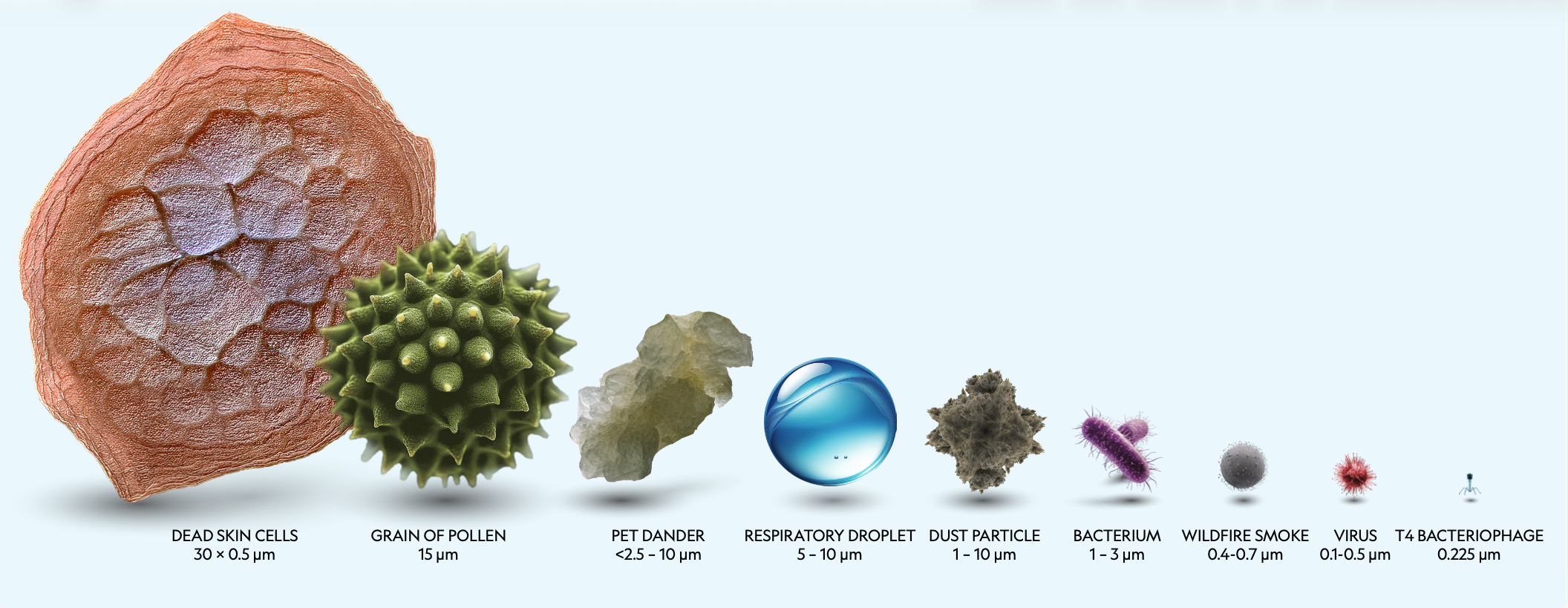
Bioaerosols vs. Microorganisms vs. Pathogens: Key Differences
The terms are closely related but not interchangeable. Bioaerosols are the broadest category, referring to any airborne particles of biological origin, whether living or nonliving.
Microorganisms, by contrast, are living microscopic organisms like bacteria, fungi, and viruses. When these microorganisms become airborne, they qualify as bioaerosols.
Pathogens are a smaller, more specific category: microorganisms that cause disease.
Key Takeaway: All pathogens are microorganisms, and many microorganisms can be bioaerosols, but not all bioaerosols are pathogens.
This distinction matters because not every bioaerosol poses a health risk — though the ones that do can be highly impactful.
Common Examples of Bioaerosols
Airborne Bacteria, Viruses, and Fungal Spores in Indoor Air
Airborne bacteria such as Legionella pneumophila can spread through contaminated water aerosols, causing outbreaks of Legionnaires’ disease.
Viruses including influenza, rhinovirus (the common cold), and SARS-CoV-2 also fall into this category.
Meanwhile, fungal spores like Aspergillus, Cladosporium, and Penicillium are common in indoor air and are well-known triggers for allergies and asthma.
Pollen, Plant Debris, and Other Plant-Derived Bioaerosols
Seasonal pollen remains one of the most recognizable bioaerosols, but plant debris also plays a role. Microscopic fragments of leaves, stems, and wood can enter buildings through windows and ventilation systems, irritating those with sensitive airways.
Human and Animal Sources: Skin Cells, Pet Dander, and Allergens
Humans shed millions of skin cells each day, which not only become airborne but also provide food for dust mites. Pet dander and hair are among the most common allergens in households.
Insects and rodents also contribute fecal particles and other fragments that become airborne in poorly maintained spaces.
Even protozoa and algae can occasionally appear in the air under certain conditions, particularly where water activity is high.
Biological Byproducts: Endotoxins, Mycotoxins, and Other Airborne Contaminants
Beyond living organisms themselves, biological byproducts such as endotoxins (from bacterial cell walls) and mycotoxins (toxic substances produced by certain molds) represent another category of bioaerosols.
These can provoke strong immune reactions, respiratory issues, or even neurological effects depending on exposure.
Where Do Bioaerosols Come From?
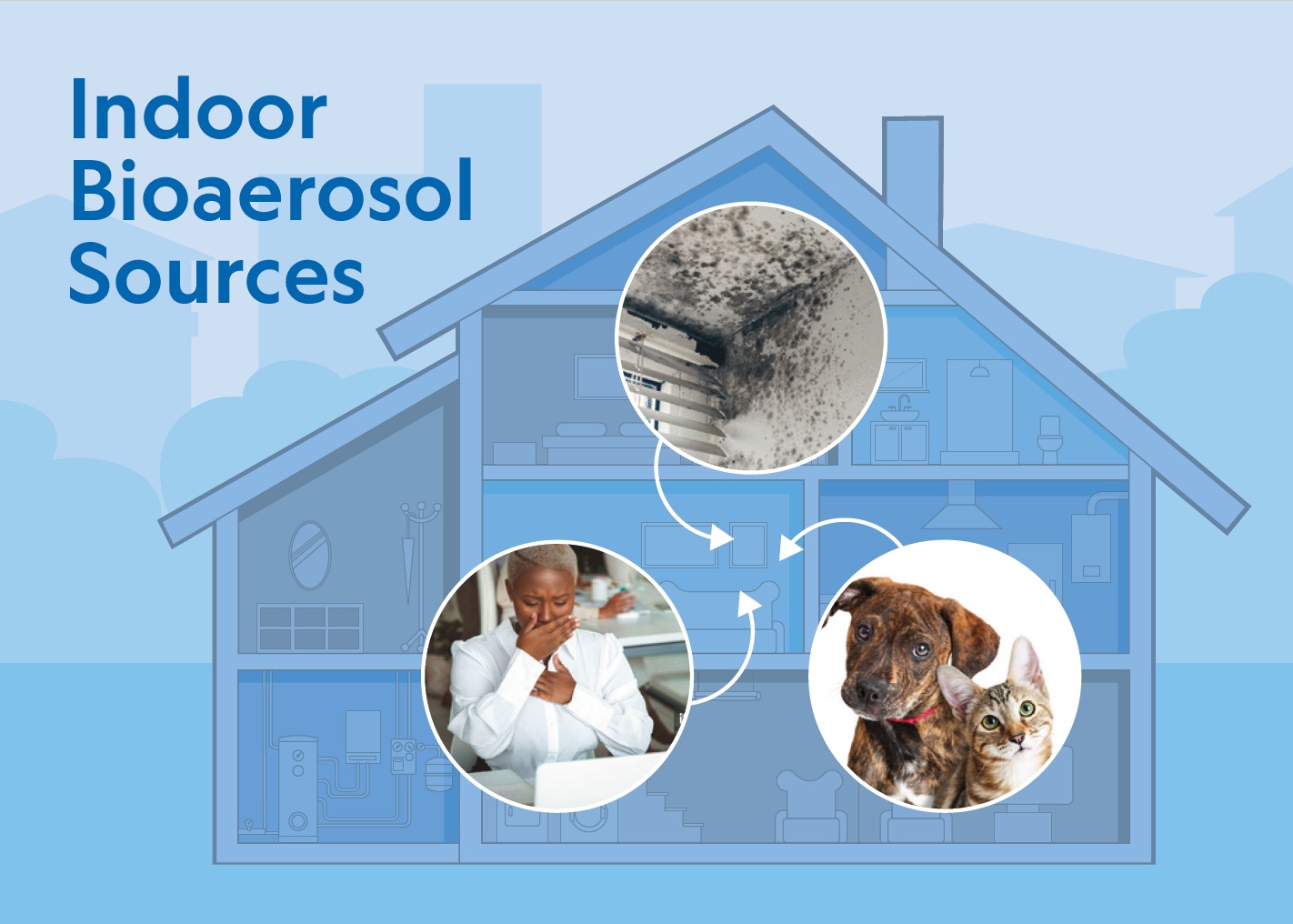
Indoor Sources of Bioaerosols: People, Pets, and Building Materials
Indoor environments are often significant reservoirs for bioaerosols. Humans and animals constantly release particles through breathing, coughing, sneezing, skin shedding, and saliva.
HVAC systems can harbor bacteria or mold on damp filters and coils, spreading them throughout a building. Plumbing and drains form biofilms that can become aerosolized, while building materials such as carpets, drywall, and insulation support microbial growth if moisture is present.
Even daily activities like vacuuming, sweeping, or simply walking across a carpet resuspend settled particles back into the air.
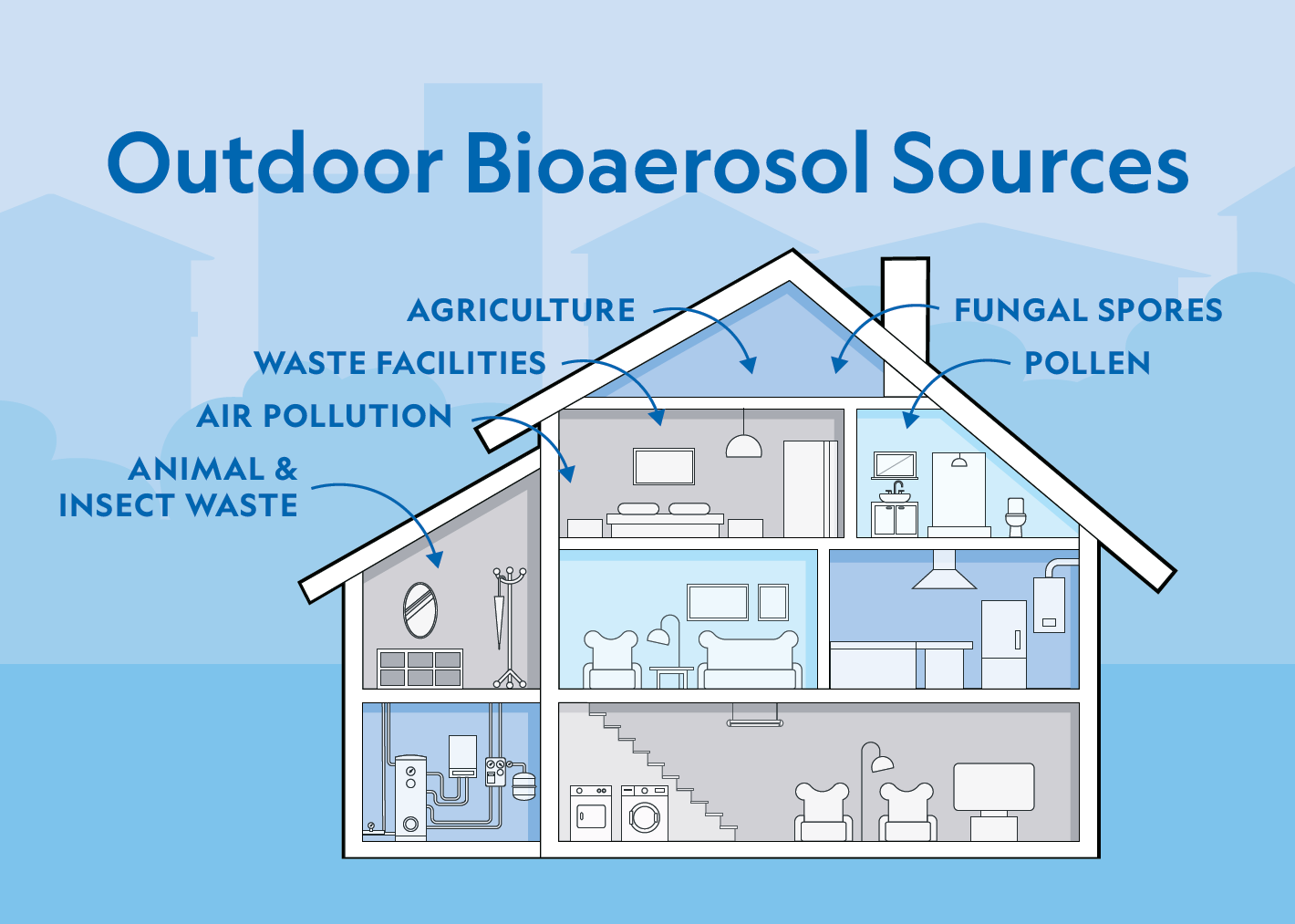
Outdoor Sources of Bioaerosols: Pollen, Soil, and Agricultural Activities
Outdoors, soil and vegetation release fungal spores, pollen, and plant debris that can be carried indoors. Agricultural operations, waste facilities, and compost piles release large quantities of bioaerosols into the air.
Dust storms and air pollution events can transport microbial contaminants long distances. Animals and insects also contribute bioaerosols through droppings, nesting materials, or pathogens carried inside.
The Role of Moisture and Humidity in Bioaerosol Growth
Moisture is a critical driver of bioaerosol growth and release. High humidity, water leaks, or water-damaged building materials provide an ideal environment for microbial activity. Once growth begins, spores and fragments are easily dispersed into the air, significantly increasing indoor concentrations.
Why Bioaerosols Matter to Our Health
Want to reduce these particles in your building or home? Learn how Plasma Air’s bipolar ionization units tackle bioaerosols at the source.
Unlike ordinary dust or smoke particles, bioaerosols interact directly with our immune systems. Their effects range from mild irritation to severe illness, depending on type, concentration, and duration of exposure.
Allergies and Asthma Triggers from Bioaerosols
Pollen, mold spores, and pet dander are leading triggers of allergic rhinitis. According to the American Academy of Allergy, Asthma & Immunology, up to 30% of adults and 40% of children experience allergies, with airborne allergens among the primary culprits.
Damp indoor environments are especially problematic: a World Health Organization review concluded that dampness and mold increase asthma risk by 30–50%.
Respiratory and Immune System Effects of Airborne Contaminants
Even non-pathogenic microbial fragments can cause chronic inflammation in the respiratory system. Endotoxins, for example, are linked to bronchitis, COPD, and hypersensitivity pneumonitis.
Longterm exposure to such bioaerosols contributes to sick building syndrome, where occupants experience fatigue, headaches, and persistent respiratory irritation.
Infectious Disease Transmission Through Airborne Pathogens
Airborne viruses such as influenza and SARS-CoV-2 spread primarily through bioaerosols. The CDC has noted that airborne pathogens remain suspended indoors for hours, increasing infection risks compared to outdoor environments.
Bacteria like Legionella pneumophila, when aerosolized from plumbing systems, can cause outbreaks of severe pneumonia.
Vulnerable Populations at Greater Risk from Bioaerosols
Certain groups are more at risk from bioaerosols, including children, elderly adults, and immunocompromised individuals. In healthcare environments, patients with weakened immune systems may face serious health threats even from relatively low concentrations of airborne pathogens.
How Air Purification Helps Reduce Airborne Pathogens
While ventilation, moisture control, and cleaning are essential, air purification and air cleaners play critical roles in capturing or inactivating bioaerosols before they are inhaled.
HEPA Filtration for Bioaerosols, Viruses, and Allergens: HEPA air purification uses filters that capture 99.97% of particles as small as 0.3 μm, including viruses, bacteria, spores, and allergens. Real-world studies have shown that HEPA-equipped units can reduce airborne SARS-CoV-2 RNA levels in classrooms by 30–60%.
NanoStrike™ Technology for Pathogen Inactivation: This nanotechnology inactivates airborne pathogens instantly. It harnesses a range of physical concurrent pathogen inactivation processes to safely burst airborne pathogen cells, rapidly inactivating them, helping to ensure they are no longer a threat of infection, and no future antimicrobial resistance can develop.
Multi-Stage Air Disinfection with HEPA and Carbon Filtration: These advanced, portable air disinfection and air cleaning systems combine NanoStrike technology and multi-stage filtration (Pre, HEPA, Carbon) to offer broader protection across different types of bioaerosols.
Soft Ionization—Cleaner Air Without Ozone: This technology, also known as bipolar ionization, releases charged ions into the air, inactivating viruses and bacteria, while clustering particuate matter, like allergens, to make them easier to capture in filters. It’s important to note these solutions are UL 2998 validated for zero ozone, as ozone poses its own health risks.
Conclusion
Controlling the Invisible Threat
Bioaerosols are a hidden yet powerful factor in indoor air quality. From allergens that trigger sneezing fits to pathogens capable of spreading illness, these microscopic particles directly influence human health.
The encouraging news is that we have the tools to manage their impact. With clean air solutions such as HEPA filtration, in-room air disinfection, soft ionization (bipolar ionization), and multi-stage purification systems, it’s possible to significantly reduce exposure to harmful bioaerosols.
As schools, offices, healthcare facilities, and homes continue prioritizing healthier environments, tackling bioaerosols should be central to every indoor air quality strategy.
By raising awareness of these invisible particles — and taking proactive steps to control them — we can create safer, cleaner air for everyone.
Take the Next Step To Clean Indoor Air
Bioaerosols are just one piece of the indoor air quality puzzle — but they’re a critical one. The right solutions can help reduce airborne pathogens, allergens, and other invisible contaminants in schools, offices, healthcare facilities, and homes.
Explore WellAir’s solutions to learn how our advanced technologies, including NanoStrike™ with multi-stage HEPA systems, and soft ionization, can help you create safer, healthier environments.
